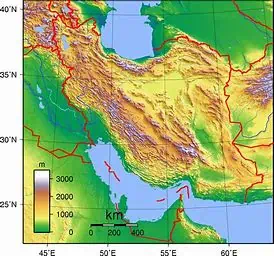Persian Plateau population likely moved into Central Europe and then Western Europe
 New Study out shows more evidence of long separation of Europeans and Africans. The genetic evidence is now backing up fossil evidence. At least 200k years of European separation from Africans, possibly as much as 300k.
New Study out shows more evidence of long separation of Europeans and Africans. The genetic evidence is now backing up fossil evidence. At least 200k years of European separation from Africans, possibly as much as 300k.
The paper that has received great attention in mainstream science media, posits that modern humans had a period of about 20,000 years in what is now northern Persia, before migrating both to the east and the west.
An article at MSN asks:
Where did Homo sapiens go after leaving Africa? Our species emerged in Africa 300,000 years ago, with a migration out of the continent 60,000 to 70,000 years ago.
They go on to note that our species existed in bands and lingered as a homogenous population for 20,000 years.
As Martha Christina a genetics researcher from South Africa notes, they were the beginnings of Hapol types: R, Q, P1 and West Asian mtDNA U and R1B.
From Phys.org, March 24,
Persian plateau unveiled as crucial hub for early human migration out of Africa
 A new study combining genetic, paleoecological, and archaeological evidence has unveiled the Persian Plateau as a pivotal geographic location serving as a hub for Homo sapiens during the early stages of their migration out of Africa.
A new study combining genetic, paleoecological, and archaeological evidence has unveiled the Persian Plateau as a pivotal geographic location serving as a hub for Homo sapiens during the early stages of their migration out of Africa.
-
- The Persian plateau as a hub for early human settlement: Using a novel genetic approach combined with paleoecological modeling, the study revealed the Persian Plateau as the region where from population waves that settled all of Eurasia originated.
And of greatest relevance to readers of this site:
-
- Genetic resemblance in ancient and modern populations: The genetic component identified in populations from the Persian Plateau underlines its long-lasting differentiation in the area, compatible with the hub nature of the region, and is ancestral to the genetic components already known to have inhabited the Plateau.
-
- Such a genetic signature was detected thanks to a new approach that disentangles 40,000 years of admixture and other confounding events. This genetic connection underscores the Plateau’s significance as a pivotal location for early human settlement and subsequent migrations.
The Persian plateau served as hub for Homo sapiens after the main out of Africa dispersal
 The geographic whereabouts of these early settlers in the timeframe between ~70-60 to 45 kya has been difficult to reconcile. Here we combine genetic evidence and palaeoecological models to infer the geographic location that acted as the Hub for our species during the early phases of colonisation of Eurasia.
The geographic whereabouts of these early settlers in the timeframe between ~70-60 to 45 kya has been difficult to reconcile. Here we combine genetic evidence and palaeoecological models to infer the geographic location that acted as the Hub for our species during the early phases of colonisation of Eurasia.
Prehistoric Humans Spent 20,000 Years Living on ‘Persian Plateau’ After Leaving Africa, New Study Suggests
Added to the evidence that we have already covered at this site, this amounts to continuity to Western European populations including Gravettians, Solutreans and Magdalenians.


